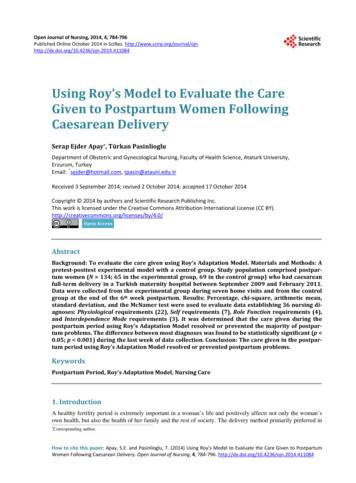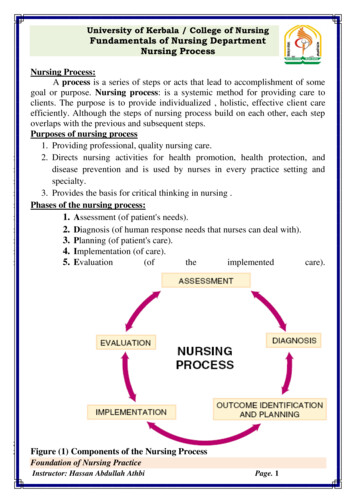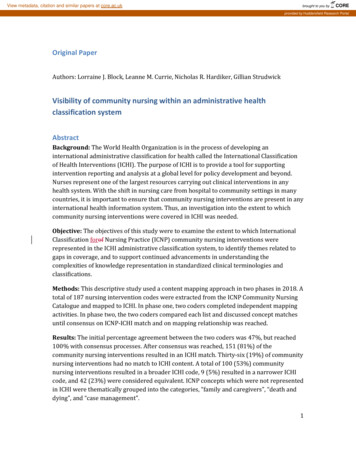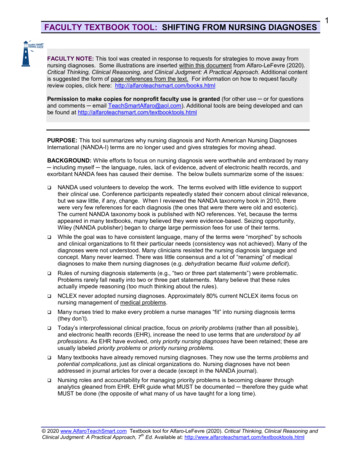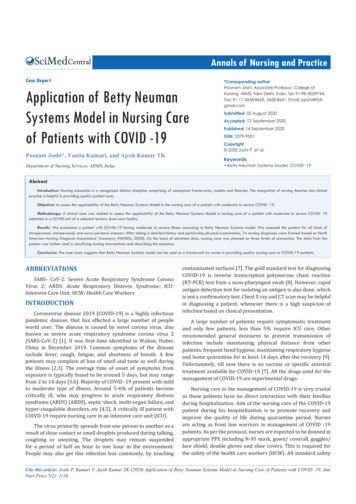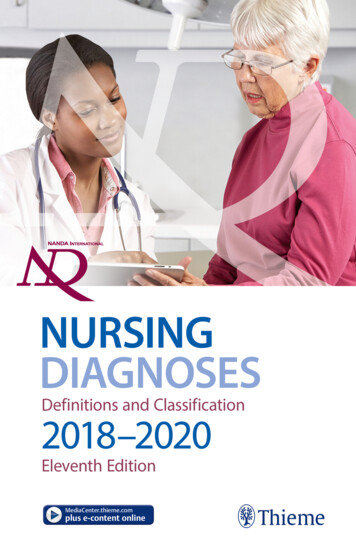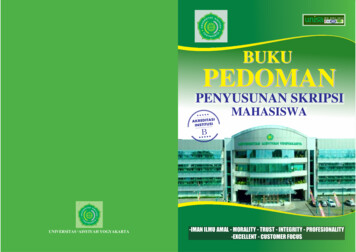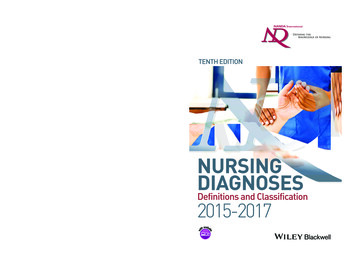
Transcription
20mmNURSING DIAGNOSESDefinitions and Classification
NANDA International, Inc.NURSING DIAGNOSES:Definitions & Classification2015–2017
NANDA International, Inc.NURSING DIAGNOSES:Definitions & Classification2015–2017Tenth EditionEdited byT. Heather Herdman, PhD, RN, FNIandShigemi Kamitsuru, PhD, RN, FNI
This edition first published 2014 2014, 2012, 2009, 2007, 2005, 2003, 2001, 1998, 1996, 1994 by NANDA International, Inc.Registered officeJohn Wiley & Sons, Ltd., The Atrium, Southern Gate, Chichester, West Sussex, PO19 8SQ, UKEditorial offices9600 Garsington Road, Oxford, OX4 2DQ, UKThe Atrium, Southern Gate, Chichester, West Sussex, PO19 8SQ, UK1606 Golden Aspen Drive, Suites 103 and 104, Ames, Iowa 50010, USAFor details of our global editorial offices, for customer services and for information about howto apply for permission to reuse the copyright material in this book please see our website atwww.wiley.com/wiley-blackwellThe right of the author to be identified as the author of this work has been asserted in accordancewith the UK Copyright, Designs and Patents Act 1988.All rights reserved. No part of this publication may be reproduced, stored in a retrieval system, ortransmitted, in any form or by any means, electronic, mechanical, photocopying, recording orotherwise, except as permitted by the UK Copyright, Designs and Patents Act 1988, without theprior permission of the publisher.Designations used by companies to distinguish their products are often claimed as trademarks. Allbrand names and product names used in this book are trade names, service marks, trademarks orregistered trademarks of their respective owners. The publisher is not associated with any productor vendor mentioned in this book. It is sold on the understanding that the publisher is not engagedin rendering professional services. If professional advice or other expert assistance is required,the services of a competent professional should be sought.The contents of this work are intended to further general scientific research, understanding, anddiscussion only and are not intended and should not be relied upon as recommending or promotinga specific method, diagnosis, or treatment by health science practitioners for any particular patient.The publisher and the author make no representations or warranties with respect to the accuracy orcompleteness of the contents of this work and specifically disclaim all warranties, including withoutlimitation any implied warranties of fitness for a particular purpose. In view of ongoing research,equipment modifications, changes in governmental regulations, and the constant flow of informationrelating to the use of medicines, equipment, and devices, the reader is urged to review and evaluatethe information provided in the package insert or instructions for each medicine, equipment, ordevice for, among other things, any changes in the instructions or indication of usage and for addedwarnings and precautions. Readers should consult with a specialist where appropriate. The fact thatan organization or Website is referred to in this work as a citation and/or a potential source offurther information does not mean that the author or the publisher endorses the information theorganization or Website may provide or recommendations it may make. Further, readers should beaware that Internet Websites listed in this work may have changed or disappeared between whenthis work was written and when it is read. No warranty may be created or extended by anypromotional statements for this work. Neither the publisher nor the author shall be liable forany damages arising herefrom.ISBN 9781118914939ISSN 1943-0728A catalogue record for this book is available from the Library of Congress and the British Library.Wiley also publishes its books in a variety of electronic formats. Some content that appears in printmay not be available in electronic books.Cover image: iStockphoto / alvarezSet in 10/12pt Meridien by SPi Publisher Services, Pondicherry, India12014Correct citation of this text (APA Format, based on the 6th Edition):Herdman, T.H. & Kamitsuru, S. (Eds.). (2014). NANDA International NursingDiagnoses: Definitions & Classification, 2015–2017. Oxford: Wiley Blackwell.
ContentsNANDA International, Inc. Guidelines for Copyright Permission xixPreface xxiiIntroduction xxviAbout the Companion Website xxviiiPart 1 Changes to the NANDAInternational Terminology 1Introduction 3T. Heather Herdman, RN, PhD, FNI What’s New in the 2015–2017 Edition ofDiagnoses and Classification?Acknowledgments 4Chapter authors 4Chapter reviewers 5Reviewer for standardization of diagnostic terms 5Changes to health promotion and risk diagnoses 5New nursing diagnoses, 2015–2017 5Table 1.1 New NANDA-I Nursing Diagnoses,2015–2017 6Revised nursing diagnoses, 2015–2017 7Table 1.2 Revised NANDA-I Nursing Diagnoses,2015–2017 8Changes to slotting of current diagnoses withinthe NANDA-I Taxonomy II, 2015–2017 11Table 1.3 Slotting Changes to NANDA-INursing Diagnoses, 2015–2017 11Revisions to nursing diagnosis labels within theNANDA-I Taxonomy II, 2015–2017 11Nursing diagnoses removed from the NANDA-ITaxonomy II, 2015–2017 11Table 1.4 Revisions to Nursing DiagnosisLabels of NANDA-I Nursing Diagnoses,2015–2017 12Standardization of diagnostic indicator terms 12Contents v
Table 1.5 Nursing Diagnoses Removed from theNANDA-I Taxonomy II, 2015–2017 Other changes made in the 2015–2017 edition Part 2 Nursing Diagnosis 131517Chapter 1 Nursing Diagnosis Basics 21Susan Gallagher-Lepak, RN, PhDFigure 1.1 Example of a Collaborative Healthcare Team 22How does a nurse (or nursing student) diagnose? 23Figure 1.2 The Modified Nursing Process 23Understanding nursing concepts 24Assessment 24Nursing diagnosis 25Table 1.1 Parts of a Nursing Diagnosis Label 25Table 1.2 Key Terms at a Glance 26Planning/intervention 27Evaluation 28Use of nursing diagnosis 28Brief chapter summary 29Questions commonly asked by new learnersabout nursing diagnosis 29References 30Chapter 2 From Assessment to Diagnosis T. Heather Herdman, RN, PhD, FNI andShigemi Kamitsuru, RN, PhD, FNIWhat happens during nursing assessment? Figure 2.1 Steps in Moving from Assessmentto Diagnosis Why do nurses assess? The screening assessment Not a simple matter of “filling in the blanks” Assessment framework Should we use the NANDA-I taxonomyas an assessment framework? Data analysis Figure 2.2 Converting Data to Information Subjective versus objective data Clustering of information/seeing a pattern Figure 2.3 The Modified Nursing Process Identifying potential nursing diagnoses(diagnostic hypotheses) In-depth assessment Figure 2.4 In-Depth Assessment vi Contents31313232333435353536373839394142
Confirming/refuting potential nursing diagnoses 43Eliminating possible diagnoses 43Potential new diagnoses 44Differentiating between similar diagnoses 44Table 2.1 The Case of Caroline: A Comparisonof Identified Defining Characteristics andRelated Factors 45Table 2.2 The Case of Caroline: A Comparisonof Domains and Classes of PotentialDiagnoses 47Figure 2.5 SEA TOW: A Thinking Tool forDiagnostic Decision-Making 48Making a diagnosis/prioritizing 49Summary 50References 50Chapter 3 An Introduction to the NANDA-ITaxonomy 52T. Heather Herdman, RN, PhD, FNITaxonomy: Visualizing a taxonomic structure 52Figure 3.1 Domains and Classes of ClassifiedGroceries, Inc. 54Figure 3.2 Classes and Concepts of ClassifiedGroceries, Inc. 55Classification in nursing 56Figure 3.3 NANDA-I Taxonomy II Domainsand Classes 58Figure 3.4 NANDA-I Domain 1, Health Promotion,with Classes and Nursing Diagnoses 60Using the NANDA-I taxonomy 60Structuring nursing curricula 60Figure 3.5 NANDA-I Taxonomy II Activity/RestDomain 61Identifying a nursing diagnosis outside your areaof expertise 62Figure 3.6 Use of the NANDA-I Taxonomy II andTerminology to Identify and Validate a NursingDiagnosis Outside the Nurse’s Area of Expertise 63Case Study: Mrs. Lendo 64Figure 3.7 Diagnosing Mrs. Lendo 65The NANDA-I nursing diagnosis taxonomy:A short history 65Table 3.1 Domains, Classes, and Nursing Diagnosesin the NANDA-I Taxonomy II 66Contents vii
Figure 3.8 Seven Domains of the ProposedTaxonomy III 79Figure 3.9 Proposed Taxonomy III Domainsand Classes 80Table 3.2 Proposed Taxonomy III Domains, Classes,and Nursing Diagnoses 81References 90Chapter 4 NANDA-I Taxonomy II: Specificationsand Definitions 91T. Heather Herdman, RN, PhD, FNIStructure of Taxonomy II 91Figure 4.1 The ISO Reference Terminology Modelfor a Nursing Diagnosis 92A multiaxial system for constructing diagnostic concepts 92Figure 4.2 The NANDA-I Model of a NursingDiagnosis 93Definitions of the axes 94Axis 1 The focus of the diagnosis 94Table 4.1 Foci of the NANDA-I Nursing Diagnoses 95Axis 2 Subject of the diagnosis 97Axis 3 Judgment 97Axis 4 Location 97Table 4.2 Definitions of Judgment Termsfor Axis 3, NANDA-I Taxonomy II 98Table 4.3 Locations in Axis 4, NANDA-I Taxonomy II 100Axis 5 Age 100Axis 6 Time 100Axis 7 Status of the diagnosis 100Developing and submitting a nursing diagnosis 101Figure 4.3 A NANDA-I Nursing Diagnosis Model:(Individual) Impaired Standing 101Figure 4.4 A NANDA-I Nursing Diagnosis Model:Risk for Disorganized Infant Behavior 102Figure 4.5 A NANDA-I Nursing Diagnosis Model:Readiness for Enhanced Family Coping 102Further development 103References 103Other recommended reading 104Chapter 5 Frequently Asked Questions T. Heather Herdman, RN, PhD, FNI andShigemi Kamitsuru, RN, PhD, FNIBasic questions about standardized nursing languages Basic questions about NANDA-I viii Contents105105106
Basic questions about nursing diagnoses 110Questions about defining characteristics 116Questions about related factors 117Questions about risk factors 118Differentiating between similar nursing diagnoses 119Questions regarding the development of a treatment plan 121Questions about teaching/learning nursing diagnoses 123Questions about using NANDA-I in electronic healthrecords 126Questions about diagnosis development and review 127Questions about the NANDA-I Definitions andClassification text 127References 129Part 3 The NANDA InternationalNursing Diagnoses International Considerations on the useof the NANDA-I Nursing Diagnoses T. Heather Herdman, RN, PhD, FNI131133Domain 1: Health Promotion 137Class 1. Health awareness 139Deficient diversional activity – 00097 139Sedentary lifestyle – 00168 140Class 2. Health management 141Frail elderly syndrome – 00257 141Risk for frail elderly syndrome – 00231 142Deficient community health – 00215 144Risk-prone health behavior – 00188 145Ineffective health maintenance – 00099 146Ineffective health management – 00078 147Readiness for enhanced health management – 00162 148Ineffective family health management – 00080 149Noncompliance – 00079 150Ineffective protection – 00043 152Domain 2: Nutrition 153Class 1. Ingestion 155Insufficient breast milk – 00216 155Ineffective breastfeeding – 00104 156Interrupted breastfeeding – 00105 158Readiness for enhanced breastfeeding – 00106 159Contents ix
Ineffective infant feeding pattern – 00107 160Imbalanced nutrition: less than bodyrequirements – 00002 161Readiness for enhanced nutrition – 00163 162Obesity – 00232 163Overweight – 00233 165Risk for overweight – 00234 167Impaired swallowing – 00103 169Class 2. Digestion None at present time Class 3. Absorption None at present time Class 4. Metabolism 171Risk for unstable blood glucose level – 00179 171Neonatal jaundice – 00194 172Risk for neonatal jaundice – 00230 173Risk for impaired liver function – 00178 174Class 5. Hydration 175Risk for electrolyte imbalance – 00195 175Readiness for enhanced fluid balance – 00160 176Deficient fluid volume – 00027 177Risk for deficient fluid volume – 00028 178Excess fluid volume – 00026 179Risk for imbalanced fluid volume – 00025 180Domain 3: Elimination and Exchange 181Class 1. Urinary function 183Impaired urinary elimination – 00016 183Readiness for enhanced urinaryelimination – 00166 184Functional urinary incontinence – 00020 185Overflow urinary incontinence – 00176 186Reflex urinary incontinence – 00018 187Stress urinary incontinence – 00017 188Urge urinary incontinence – 00019 189Risk for urge urinary incontinence – 00022 190Urinary retention – 00023 191Class 2. Gastrointestinal function 192Constipation – 00011 192Risk for constipation – 00015 194Chronic functional constipation – 00235 196Risk for chronic functional constipation – 00236 198Perceived constipation – 00012 199Diarrhea – 00013 200x Contents
Dysfunctional gastrointestinal motility – 00196 201Risk for dysfunctional gastrointestinalmotility – 00197 202Bowel incontinence – 00014 203Class 3. Integumentary function None at this time Class 4. Respiratory function 204Impaired gas exchange – 00030 204Domain 4: Activity/Rest 205Class 1. Sleep/rest 209Insomnia – 00095 209Sleep deprivation – 00096 210Readiness for enhanced sleep – 00165 212Disturbed sleep pattern – 00198 213Class 2. Activity/exercise 214Risk for disuse syndrome – 00040 214Impaired bed mobility – 00091 215Impaired physical mobility – 00085 216Impaired wheelchair mobility – 00089 218Impaired sitting – 00237 219Impaired standing – 00238 220Impaired transfer ability – 00090 221Impaired walking – 00088 222Class 3. Energy balance 223Fatigue – 00093 223Wandering – 00154 224Class 4. Cardiovascular/pulmonary responses 225Activity intolerance – 00092 225Risk for activity intolerance – 00094 226Ineffective breathing pattern – 00032 227Decreased cardiac output – 00029 228Risk for decreased cardiac output – 00240 230Risk for impaired cardiovascular function – 00239 231Risk for ineffective gastrointestinalperfusion – 00202 232Risk for ineffective renal perfusion – 00203 233Impaired spontaneous ventilation – 00033 234Risk for decreased cardiac tissue perfusion – 00200 235Risk for ineffective cerebral tissueperfusion – 00201 236Ineffective peripheral tissue perfusion – 00204 237Risk for ineffective peripheral tissueperfusion – 00228 238Contents xi
Dysfunctional ventilatory weaningresponse – 00034 239Class 5. Self-care 241Impaired home maintenance – 00098 241Bathing self-care deficit – 00108 242Dressing self-care deficit – 00109 243Feeding self-care deficit – 00102 244Toileting self-care deficit – 00110 245Readiness for enhanced self-care – 00182 246Self-neglect – 00193 247Domain 5: Perception/Cognition 249Class 1. Attention 251Unilateral neglect – 00123 251Class 2. Orientation None at this time Class 3. Sensation/perception None at this time Class 4. Cognition 252Acute confusion – 00128 252Risk for acute confusion – 00173 253Chronic confusion – 00129 254Labile emotional control – 00251 255Ineffective impulse control – 00222 256Deficient knowledge – 00126 257Readiness for enhanced knowledge – 00161 258Impaired memory – 00131 259Class 5. Communication 260Readiness for enhanced communication –00157 260Impaired verbal communication – 00051 261Domain 6: Self-Perception 263Class 1. Self-concept 265Readiness for enhanced hope – 00185 265Hopelessness – 00124 266Risk for compromised human dignity – 00174 267Disturbed personal identity – 00121 268Risk for disturbed personal identity – 00225 269Readiness for enhanced self-concept – 00167 270Class 2. Self-esteem 271Chronic low self-esteem – 00119 271Risk for chronic low self-esteem – 00224 272Situational low self-esteem – 00120 273xii Contents
Risk for situational low self-esteem – 00153 274Class 3. Body image 275Disturbed body image – 00118 275Domain 7: Role Relationships 277Class 1. Caregiving roles 279Caregiver role strain – 00061 279Risk for caregiver role strain – 00062 282Impaired parenting – 00056 283Readiness for enhanced parenting – 00164 286Risk for impaired parenting – 00057 287Class 2. Family relationships 289Risk for impaired attachment – 00058 289Dysfunctional family processes – 00063 290Interrupted family processes – 00060 293Readiness for enhanced family processes –00159 294Class 3. Role performance 295Ineffective relationship – 00223 295Readiness for enhanced relationship – 00207 296Risk for ineffective relationship – 00229 297Parental role conflict – 00064 298Ineffective role performance – 00055 299Impaired social interaction – 00052 301Domain 8: Sexuality 303Class 1. Sexual identity None at present time Class 2. Sexual function 305Sexual dysfunction – 00059 305Ineffective sexuality pattern – 00065 306Class 3. Reproduction 307Ineffective childbearing process – 00221 307Readiness for enhanced childbearing process –00208 309Risk for ineffective childbearing process –00227 310Risk for disturbed maternal–fetal dyad – 00209 311Domain 9: Coping/Stress Tolerance Class 1. Post-trauma responses Post-trauma syndrome – 00141 Risk for post-trauma syndrome – 00145 Rape-trauma syndrome – 00142 313315315317318Contents xiii
Relocation stress syndrome – 00114 319Risk for relocation stress syndrome – 00149 320Class 2. Coping responses 321Ineffective activity planning – 00199 321Risk for ineffective activity planning – 00226 322Anxiety – 00146 323Defensive coping – 00071 325Ineffective coping – 00069 326Readiness for enhanced coping – 00158 327Ineffective community coping – 00077 328Readiness for enhanced community coping – 00076 329Compromised family coping – 00074 330Disabled family coping – 00073 332Readiness for enhanced family coping – 00075 333Death anxiety – 00147 334Ineffective denial – 00072 335Fear – 00148 336Grieving – 00136 338Complicated grieving – 00135 339Risk for complicated grieving – 00172 340Impaired mood regulation – 00241 341Readiness for enhanced power – 00187 342Powerlessness – 00125 343Risk for powerlessness – 00152 344Impaired resilience – 00210 345Readiness for enhanced resilience – 00212 346Risk for impaired resilience – 00211 347Chronic sorrow – 00137 348Stress overload – 00177 349Class 3. Neurobehavioral stress 350Decreased intracranial adaptive capacity – 00049 350Autonomic dysreflexia – 00009 351Risk for autonomic dysreflexia – 00010 352Disorganized infant behavior – 00116 354Readiness for enhanced organized infantbehavior – 00117 356Risk for disorganized infant behavior – 00115 357Domain 10: Life Principles 359Class 1. Values None at this time Class 2. Beliefs 361Readiness for enhanced spiritual well-being –00068 361xiv Contents
Class 3. Value/belief/action congruence 363Readiness for enhanced decision-making –00184 363Decisional conflict – 00083 364Impaired emancipated decision-making – 00242 365Readiness for enhanced emancipateddecision-making – 00243 366Risk for impaired emancipated decision-making –00244 367Moral distress – 00175 368Impaired religiosity – 00169 369Readiness for enhanced religiosity – 00171 370Risk for impaired religiosity – 00170 371Spiritual distress – 00066 372Risk for spiritual distress – 00067 374Domain 11: Safety/Protection 375Class 1. Infection 379Risk for infection – 00004 379Class 2. Physical injury 380Ineffective airway clearance – 00031 380Risk for aspiration – 00039 381Risk for bleeding – 00206 382Risk for dry eye – 00219 383Risk for falls – 00155 384Risk for injury – 00035 386Risk for corneal injury – 00245 387Risk for perioperative positioning injury –00087 388Risk for thermal injury – 00220 389Risk for urinary tract injury – 00250 390Impaired dentition – 00048 391Impaired oral mucous membrane – 00045 392Risk for impaired oral mucous membrane –00247 394Risk for peripheral neurovasculardysfunction – 00086 395Risk for pressure ulcer – 00249 396Risk for shock – 00205 398Impaired skin integrity – 00046 399Risk for impaired skin integrity – 00047 400Risk for sudden infant death syndrome – 00156 401Risk for suffocation – 00036 402Delayed surgical recovery – 00100 403Contents xv
Risk for delayed surgical recovery – 00246 404Impaired tissue integrity – 00044 405Risk for impaired tissue integrity – 00248 406Risk for trauma – 00038 407Risk for vascular trauma – 00213 409Class 3. Violence 410Risk for other-directed violence – 00138 410Risk for self-directed violence – 00140 411Self-mutilation – 00151 412Risk for self-mutilation – 00139 414Risk for suicide – 00150 416Class 4. Environmental hazards 418Contamination – 00181 418Risk for contamination – 00180 420Risk for poisoning – 00037 421Class 5. Defensive processes 422Risk for adverse reaction to iodinatedcontrast media – 00218 422Risk for allergy response – 00217 423Latex allergy response – 00041 424Risk for latex allergy response – 00042 425Class 6. Thermoregulation 426Risk for imbalanced body temperature – 00005 426Hyperthermia – 00007 427Hypothermia – 00006 428Risk for hypothermia – 00253 430Risk for perioperative hypothermia – 00254 432Ineffective thermoregulation – 00008 433Domain 12: Comfort 435Class 1. Physical comfort 437Impaired comfort – 00214 437Readiness for enhanced comfort – 00183 438Nausea – 00134 439Acute pain – 00132 440Chronic pain – 00133 442Labor pain – 00256 444Chronic pain syndrome – 00255 445Class 2. Environmental comfort 437Impaired comfort – 00214 437Readiness for enhanced comfort – 00183 438Class 3. Social comfort 437Impaired comfort – 00214 437xvi Contents
Readiness for enhanced comfort – 00183 Risk for loneliness – 00054 Social isolation – 00053 438446447Domain 13: Growth/Development 449Class 1. Growth 451Risk for disproportionate growth – 00113 451Class 2. Development 452Risk for delayed development – 00112 452Nursing Diagnoses Accepted for Developmentand Clinical Validation 2015–2017 Disturbed energy field – 00050 455455Part 4 NANDA International, Inc.2015–2017 457NANDA International Position Statements 459The use of Taxonomy II as an assessmentframework 459The structure of the Nursing Diagnosis statementwhen included in a care plan 459NANDA International Processes and Proceduresfor Diagnosis Submission and Review NANDA-I Diagnosis Submission: Levelof evidence criteria 461461Glossary of Terms 464Nursing diagnosis 464Diagnostic axes 465Components of a nursing diagnosis 467Definitions for classification of nursing diagnoses 468References 469An Invitation to Join NANDA International NANDA International: A Member-Driven Organization Our vision Our mission Our purpose Our history 470470470470470471Contents xvii
NANDA International’s Commitment Involvement Opportunities Why join NANDA-I? Who is using the NANDA International Taxonomy? 471472472473Index 475Visit the companion website for this book at www.wiley.com/go/nursingdiagnosesxviii Contents
NANDA International, Inc. Guidelinesfor Copyright PermissionThe materials presented in this book are copyrighted and all copyrightlaws apply. For any usage other than reading or consulting the book inthe English language, a licence is required from Wiley.Examples of such reuse include but are not restricted to:A publishing house, other organization, or individual wishing totranslate the entire book, or parts thereof. An author or publishing house wishing to use the entire nursingdiagnosis taxonomy, or parts thereof, in a commercially availabletextbook or nursing manual. An author or company wishing to use the nursing diagnosistaxonomy in audio-visual materials. A software developer or computer-based patient record vendorwishing to use the nursing diagnosis taxonomy in English in a software program or application (for example, an electronic healthrecord, an e-learning course, or an electronic application for asmartphone or other electronic device). A nursing school, researcher, professional organization, or healthcare organization wishing to use the nursing diagnosis taxonomy inan educational program. A researcher wishing to use the taxonomy for non-commercialacademic research purposes. Please be aware that the proposalwill be submitted by Wiley to NANDA-I for approval beforepermission is granted. Researchers are encouraged to submitthe outcomes of their research to the International Journal ofNursing Knowledge, and to present the results at a NANDA-Iconference, as appropriate. A hospital wishing to integrate the nursing diagnosis taxonomyinto their own electronic health records. Any of the usages outlined above in a language other thanEnglish. NANDA International, Inc. Guidelines for Copyright Permission xix
Please send all requests by e-mail to: nanda@wiley.com or by post to:NANDA International Copyright RequestsGlobal Rights DepartmentJohn Wiley & Sons, LtdThe AtriumSouthern GateChichesterWest SussexPO19 8SQUKTranslations Terms and ConditionsTerms and conditions for translations will be as follows:There will be no buy-back by Wiley or NANDA-I of unsold copies ofany translations at the time that the next edition is released. Publishers cannot add or remove any content from the originalversion provided by Wiley. This includes the addition of forewords,new prefaces or comments by translators or other parties. The onlyexception to this is the addition, under the name of the editor, ofnames of the translators in each language, who should be identifiedas translators (not as authors or editors). Publishers will be required to submit the name, qualifications andrésumé of the chief translator for approval prior to commencingany translation work. Publishers must also submit both the cover design and the manuscript of the translation to Wiley for approval by NANDA-I prior toprinting the translation. NANDA-I requires up to 12 weeks tocomplete this approval process, so it should be built into theproduction schedule. Any and all changes requested by NANDA-I must be included inthe translation, and publishers shall be required to submit pageproofs for a final check before printing the translation. Publishers will also be required to grant Wiley the right to re-use andlicense the translation to third parties in electronic format. To this end,a customized version of the following Clause will be included in alltranslation licenses:The Proprietor shall have the non-exclusive right to use the Translationin any form of electronic media now known or later developed(“Electronic Rights”), to update or arrange for others to update thexx NANDA International, Inc. Guidelines for Copyright Permission
e lectronic version of the Translation when new editions of the Workbecome available and to sublicense such rights to third parties. ThePublisher shall notify the Proprietor of any suitable third parties whomay be interested in licensing the Electronic Rights from the Proprietor.The Publisher shall provide the digital files for the Translation to theProprietor in a format to be agreed, as soon as reasonably practicable, butnot later than xx months after signature of this Agreement. In consideration of the foregoing rights in this clause 1(e), the Proprietor shall pay tothe Publisher an annual royalty to be agreed.For the avoidance of doubt, we wish to make clear that this does notinclude e-book rights (unabridged verbatim electronic copies of theprint Translation), and is only intended, for example, for softwaredevelopment usages.NANDA International, Inc. Guidelines for Copyright Permission xxi
PrefaceThe 2015–2017 edition of the classic NANDA International, Inc. text,Nursing Diagnoses: Definitions & Classification, provides more clinicallyapplicable diagnoses as a result of the Diagnostic DevelopmentCommittee’s attentiveness to the potential translations of the diagnostic label, definition, defining characteristics, related factors, and riskfactors. In the past, a number of nurses asked about the applicability ofour work in their own countries and jurisdiction. Changes within the2015–2017 edition have been implemented to incorporate the diversityand practice differences across the world. The latest edition is not onlyconsidered a language, but, truthfully, it is a body of nursing k nowledge.These new and revised diagnoses are based on the state of e videncearound the world, and they are submitted by nurses, reviewed andrevised by nurses, and approved by expert nurse diagnosticians,researchers, and educators. The latest e dition enhances the culturalapplicability with 25 new nursing diagnoses and 13 revised diagnoses.Additionally, the text includes changes to the official NANDA-I nursingdiagnosis category definitions (problem-focused, risk, health promotion), and the overall nursing diagnosis definition.NANDA International, Inc. (NANDA-I) is a not-for-profit membership organization. This means that with the exception of our businessmanagement and administration functions, all of our work is accomplished by volunteers. Some of the world’s most talented nursescientists and scholars are or have been NANDA-I volunteers. Contraryto most business entities, there is not an office somewhere with nurseresearchers working on nursing diagnoses. The volunteers are peoplelike you and me who give their time and expertise to NANDA-I,because of their strongly held beliefs about the importance of patientcare and the contributions that nursing and nurses can and do maketo society.With the publication of each new edition of our work, more translations are added. I am delighted that the work is published in numerous languages for this international membership organization. Ourrelationship with our publishing partner, Wiley Blackwell, has evolvedover the past five years. One of the arrangements is to ensure thateach and every translation is accurate and exact. Together with ourpublishers, we now have a robust quality assurance mechanism inplace to ensure the accuracy of each translation. The source documentfor each translation is always this, the American English version. Weare deeply committed to ensuring the integrity of our work worldwidexxii Preface
and invite you to support us in this quest in order to improve patientsafety and the consistency of high-quality evidence-based care. As a notfor-profit organization, we obviously need an income to run the organization, facilitate meetings of our committees and Board of Directors, sponsorour website and knowledge base, and s upport educational offerings andconferences throughout the world, and this comes from the licenses wesell for the publi
Figure 3.3 NANDA-I Taxonomy II Domains and Classes 58 Figure 3.4 NANDA-I Domain 1, Health Promotion, with Classes and Nursing Diagnoses 60 Using the NANDA-I taxonomy 60 Structuring nursing curricula 60 Figure 3.5 NANDA-I Taxonomy II Activity/Rest Domain 61 Identifying a nursing diagnosis outside your area of expertise 62
